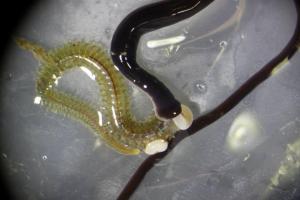Paranemertes peregrina is a species of ribbon worm that inhabits some of San Juan Island’s intertidal zones. I observed these worms in situ and collected them at Eagle Cove and False Bay. The individual pictured in the drawing, one from False Bay, measured approximately 8 cm in length when relaxed and about 11 cm when completely outstretched. In general, most worms that our class collected were about this size, but some ranged up to about 10 cm in length when relaxed. They are dorsoventrally thinned, only measuring 1 to 2 mm in height but about 5 mm in width. Dorsal color is brown/purple, and they have a peach-colored ventral side (see Figure 1). Under a dissecting microscope with a good light source, it is possible to see the coelom-based circulatory system in the form of darker brown lines within the body wall.
Figure 1. Dorsal view of a whole P. peregrina specimen, approximately 8 cm long, collected from False Bay.
Movement
These animals are slow movers on land and in water; they use circular and longitudinal muscles arranged down the length of their bodies to inch along sand and rock. The worm that I examined moved by contracting the circular and stretching the longitudinal muscles to elongate its body lengthwise and then doing the opposite to shorten the body, effectively pulling the posterior end anteriorly. At this pulling motion, the anterior end became especially flat, evidently gripping the surface beneath with the added surface area. I saw movement characteristic of only longitudinal muscle action when the individual put its head into the air and moved it side to side, evidently looking to change direction.
Mucus Secretion
When moving, the animal secreted mucus, which could be a mechanism to keep traction with the surface beneath it. I noticed more mucus on the tank walls (smooth, vertical surfaces with little traction) than sand beneath the worm. On the latter, gravity and the rough, moist sand grains aided the animal’s traction. Then, when I picked up the worm it responded by secreting a mucus covering, and I almost lost hold of it. Likely, this would be repeated against any predatory action, enabling the worm to make a slimy escape. In addition to traction and getaway, a mucus covering also helps the worms retain moisture on hot days in the harsh intertidal environment.
Habitat
At False Bay, a muddy intertidal flat, there were hundreds of individuals on the beach at low tide. It was rainy and overcast, so the nemerteans could be on the sand surface without the risk of desiccation. Eagle Cove, the other location, is a rocky intertidal zone. Although there was not nearly the abundance of Paranemertes there (possibly due to the hot weather that day) we found some living on the large rocks in the high intertidal. Although there were not comparable population sizes at the two locations, it is impressive that the species can survive in both muddy and rocky habitats. One factor enabling their habitat diversity is the presence of their prey in both of these habitats.
Feeding
P. peregrina feeds on nereid polychaetes that burrow in the intertidal sand or live in the subtidal. In the lab, we put a P. peregrina individual (9 cm long) in a dish with a nereid worm (8 cm long). After a minute or so of the nereid laying in front of P. peregrina‘s mouth, the ribbon worm everted its proboscis and latched onto its prey at the anterior end (Figure 2). At this point the nereid began to thrash, likely due to Paranemertes piercing it and injecting the neurotoxin, anabaseine (Cowles 2009). The Paranemertes individual reacted to the movement by elongating its proboscis more and more until it wrapped around the nereid, trapping it until the anabaseine took hold and the worm ceased to move. The proboscis extended to a length of a few centimeters during this process, about one third of the length of the worm. Finally, it retracted its proboscis and ingested the nereid through its mouth, anterior end first (Figure 2 and 3).
Figure 2. Dorsal view of P. peregrina in the first stage of feeding with its proboscis everted, attacking and wrapping around a nereid worm. This is the point at which Paranemertes injects anabaseine.
Figure 3. P. peregrina during the ingestion of the nereid (dorsal view). The red line on the nereid is its large dorsal blood vessel, and the posterior end of the worm is the portion still remaining to be eaten. The individual has expanded itself slightly to ingest this worm, visible by the peach colored ventral side being slightly visible in this dorsal view.
Figure 3. P. peregrina finishing the ingestion of the nereid (dorsal view). The feces of the nereid is visible at its anus; This Paranemertes individual squeezed the worm so that a large amount of its feces was deposited exteriorly and not consumed.
Maggie Doolin, Hamilton College
Cowles, Dave. Paranemertes peregrina. Walla Walla University, n.d. Web. 11 Jul 2013.




